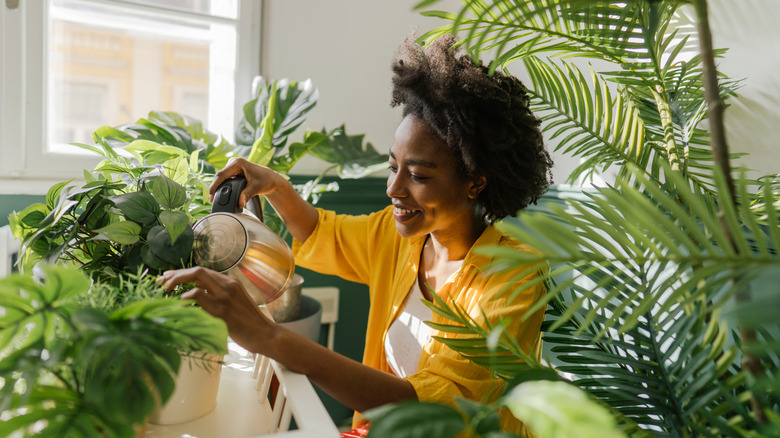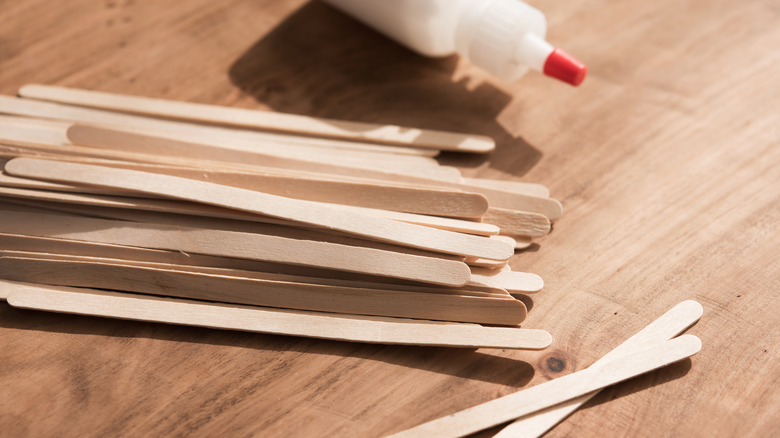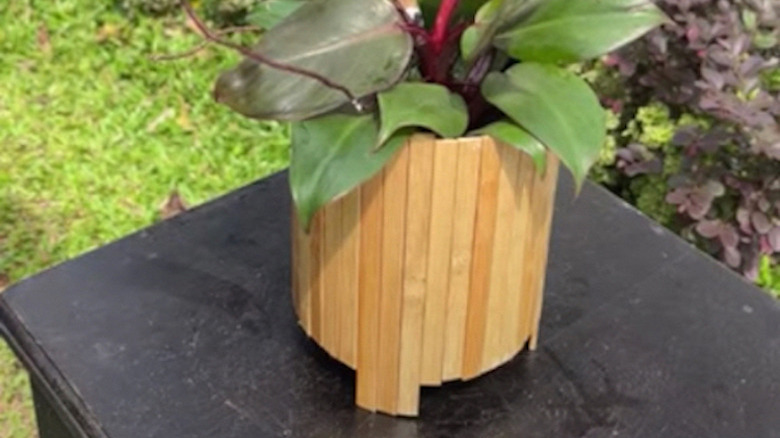Grab A Few Popsicle Sticks To Make The Perfect Home For Your Houseplants
We may receive a commission on purchases made from links.
Tired of all the bland homes your houseplants have currently? Those utilitarian plastic pots from Walmart just aren't cutting it anymore. We're totally channeling cozy, natural Nordic interiors with this DIY planter idea; it's giving shades of Pole Wrap, an unexpected kitchen backsplash material that embraces Scandinavian design. Take a well-cleaned-out tin can — or, honestly, any upcycled or new container with straight sides — and glue some stained or painted popsicle sticks to the outside. Alternate colored and plain sticks to create a subtly patterned pot that legit looks designer.
First up, you need to choose your vessel. Pretty much the only criteria is that it needs to be waterproof and the same height, or slightly shorter than, a popsicle stick. That's 4.5 inches as standard, though you can get longer jumbo sticks. A tin can works well because it's sturdy and rust-resistant (today, they're made from aluminum or coated with tin), and you can easily drill or punch holes in them. Other options include upcycled or store-bought glass jars, unglazed terracotta tumblers, and soft drink bottles cut to size. You could collect and wash the sticks from the popsicles you and your family eat (great if it's the height of summer, you have a sweet tooth, or lots of kids in the house) ... However, the more practical option, albeit less environmentally friendly, is to buy them new.
Gather everything
Amazon has a 100-pack of 4.5-inch natural popsicle sticks for very cheap, at $3.99. Aren't interested in getting paint on your hands or clothes? Get a pack of 600 4.5-inch sticks in a veritable rainbow of colors for $12.95 at Walmart. You can also buy jumbo sticks: pay CraftySticks Outlet Shop $7.95 for a 50-pack of 8-inch natural wood craft sticks. Large wooden beads — three or four of them — make great feet for standing planters, but you can use anything uniform and glueable. You'll also need a small can of interior paint or stain recommended for use on wood and glue, suitable for joining wood and whatever material your container is made from. Tools-wise, grab a drill or awl and rubber mallet, gloves and a mask for protection, a paintbrush, and a permanent marker.
If you're using an upcycled container, make sure it's thoroughly clean and dry. You don't want food or other residue contaminating the plant's soil. Set it aside, and count out the number of popsicle sticks you need. Separate out half for painting or staining — remember, wood stain takes up to 72 hours to fully dry, so plan your time accordingly. If using colored sticks, choose your colors and arrange the pattern in advance. If you need to, draw small dots on your container with the permanent marker so you know where to attach each craft stick.
Build and plant
Now's also the time to drill or punch drainage holes into the container. Once that's done, open your tube of glue and pick up the first popsicle stick. First, attach the three or four feet to the bottom of the planter, avoiding the drainage holes. Squeeze a line of glue onto one side of the stick and wait for a few seconds for it to get tacky. Press the glued side of the stick firmly in place onto your container. Repeat the process for the remaining sticks, making sure you're alternating colors according to your plan. Wait for the glue to cure before popping your plant in. Your standard all-purpose super glue might feel dry to the touch after a few minutes, but, depending on the brand, may take up to 24 hours to cure.
It's time to fill your new popsicle planter with greenery! Are you an impatient plant parent? Try fast-growing houseplants to make your interior space lush and green, like a purple passion plant, turtle vine, or arrowhead plant. Slow-growing plants might work better if your planter is on the smaller side. That way, they can live in your new popsicle pot for longer. Try a ZZ plant, dragon tree, trailing jade, or even a staghorn fern. If you didn't put any holes in your planter, you could fill it with water and use it as a vase for cut flowers rather than for growing houseplants.


